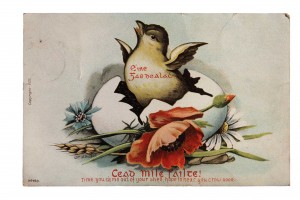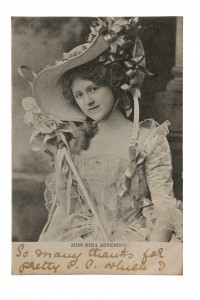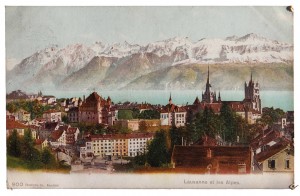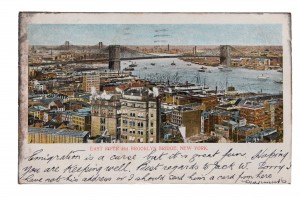A young woman’s life in Edwardian Dublin
Published in 18th-19th Century Social Perspectives, Features, Issue 6 (November/December 2014), Volume 22Christina Jessop was born in Dublin in 1878 and lived there until 1908, when she married Jack Wilson and moved with him to Cobh (then Queenstown), Co. Cork. From 1903 to 1908 she collected c. 300 picture postcards sent to her by relatives, friends and acquaintances from places as varied as London, Paris, Alaska, Switzerland and New York, and from numerous Irish locations including Cork, Belfast and Dublin. The imagery on the front of the cards includes photographed and illustrated scenery, buildings, celebrities, children and animals, humorous cartoons, artwork reproductions, and ‘real photo’ cards made from personal photographs. What historical insights are offered by a collection such as this, esp-ecially when the cards are examined holistically—front and back, image and text?
The postcards in Christina’s collection are mass-produced objects to which handwritten text and post-office stamps have been added. Much of the added text is minimal and mundane: there is a lot of short commentary on the weather, and statements like ‘No news’, ‘Write soon’ or ‘Hope you are well’. Sometimes there is no signature, or only the recipient’s name and address, or coded references such as ‘Had a great letter from “Teapot” today’, or, perhaps most frustratingly, ‘What did you think of the news?’ This sort of shorthand communication has been termed ‘activity-oriented’ by Bjarne Rogan, because it is primarily concerned with making and fostering personal and group relationships rather than with transmitting new information. It is also characteristic of most of the communication carried out today via text, email and social media.
Reading these messages is often like eavesdropping on a private conversation, where one is left intrigued but baffled. Despite this, Christina’s postcards allow an unusual opportunity to tune in to the voices of the period, the jokes and everyday casual conversations, in a way offered by very few historical sources. As Naomi Schor has written in relation to early Parisian postcards:
‘From the backs of these cards emerges a murmur of small voices speaking of minor aches and pains, long-awaited engagements, obscure family feuds; reporting on safe arrivals and unexpected delays . . . in short, carrying on the millions of minute transactions, the grain of everyday life’ (Prochaska and Mendelson 1992).
The added messages highlight the role of ordinary people as producers as well as consumers of meaning, and also testify that picture postcards are not just representations of the past—pictures and text that tell us something about it—but actual fragments which have survived from another time, objects with a history, bearing the marks of that history. Many of them are curled, torn or rain-damaged, reminding us that they do not just reflect an era but also participated actively in it.
Nationalism

Céad Mile Fáilte—nationalism was fashionable enough to be commodified in the rather clichéd images of Irishness.

The English actress and singer Nina Sevening—the majority of the cards have nothing to do with Ireland or Irishness.
One postcard in Christina’s collection, sent in 1907 by her sister Rose on her honeymoon, makes its statement by manipulating the ori-ginal ‘official’ message so that it communicates the opposite to what was intended. Underneath an image featuring the Westminster clock tower and Houses of Parliament, promoting and celebrating the institution at the heart of the British Empire, Rose has written the words ‘A United Parliament. A United People. A United EMPIRE’, only to contradict them by writing at the top: ‘All that I have written below is SARKASTICK’. This subversion is all the more cheeky when it is considered that the card travelled from London to Dublin via another canonical imperial institution, the British Post Office. The back of this card, however, reads: ‘We have gone on a wild batter and are having a day in London and Brighton before going to Paris’. Obviously the politics of empire did not deter Rose and her husband from sampling its pleasures. There is a collision here of the political and the personal and, as often happens in everyday situations, they are not entirely consistent with each other.
Christina was a member of the Keating branch of the Gaelic League, and she and some of her correspondents also exchanged postcards addressed (and sometimes entirely written) in the Irish language. This was in support of the ‘mail-in-Irish’ campaign launched by the League in 1901 to protest against the ruling of the British Post Office that all letters and packets, unless sent from Irish-speaking areas, must be addressed in English. By early 1905 the Dublin Post Office was receiving such a large amount of Irish-addressed mail that four clerks were taken from their regular duties and specially assigned to translating names and addresses into English. There were still delays and mistranslations, however, and the Post Office insisted on its right to refuse what it considered inadequately addressed mail, especially large batches. On several cards Christina’s name is mistranslated from Irish to English by the Post Office, and one of her correspondents begs her to ‘not write in Irish because I never get them till about a week after’, indicating both tepid interest in the campaign on the part of this particular friend and the usual speed with which people expected to get postcards.
Internationalism

Lausanne, Switzerland—picture postcards brought the wider world into the home of this young, middle-class woman.
In a way never possible before, picture postcards brought the spectacle of the wider world outside Ireland directly into the home of this young middle-class woman, allowing its strangest and most marvellous sights to be vicariously consumed and collected. In 1907, for instance, Christina received cards from her younger brother Charles, who had left for Alaska in 1903 to seek his fortune as a gold prospector, and from her older brother Jack, holidaying in Switzerland. Both Alaska and Switzerland—and, indeed, most locations regarded on any level as ‘significant’—were well ‘postcarded’ (that is, visually documented in postcard imagery) by the early twentieth century. Postcarding helped to form and perpetuate ideas, in Ireland as elsewhere, about what was worth seeing and representing, about how it should be represented, and about what images were worth transmitting and collecting.
As well as places, certain groups and individuals were also seen as particularly worthy of visual documentation and postcarding, categor-ised, perhaps, as curious, picturesque or exotic. Traditional rural ‘types’, particularly women, provided popular subject-matter, and the images of an Alaskan fisherwoman and an Irish peasant in Christina’s collection are examples of these. Along with the mass importation of these colourful and seductive images into Ireland, therefore, came ways of seeing and of constructing a sense of the ‘exotic’ and the ‘other’. Irish people, for example, could absorb negative ideas about African Americans from the demeaning cartoon caricatures featured on cards from the popular Happy Little Coons series published by the English postcard company Raphael Tuck. Such images, like all images, should not be seen as simply world-reflecting or even world-distorting but also as world-making, helping Irish people to form ideas about groups and countries outside Ireland, to mentally construct the world. Picture postcards therefore not only offered a means of visualising and expressing a sense of a group self, a national Irish self, but also ways of distinguishing this self from others, a sense of ‘us and them’ and ‘here and there’.
Conclusion: public meets private
Sources such as this picture postcard collection offer us insights into the major preoccupations and forces operating within Irish society at this time, and, importantly, how individuals interacted with them on an everyday level. As Judy Attfield has written, the everyday ‘is the place outside academic discourse where things are not necessarily con-veniently ordered to prevent inconceivable encounters’. So, for instance, one of Christina’s cards features an image of the Brooklyn Bridge in New York, under which her future brother-in-law has written ‘Emigration is a curse but it’s great fun’—a light-hearted if unexpected comment about what is generally considered a major Irish tragedy. The big historical picture tells us, and the writer of the card clearly knows, that mass emigration such as Ireland has experienced has been overall ‘a curse’ for the country. The small detail glimpsed via this personal communication nuances this, indicating that nevertheless, at a given point in time, for a young man in search of adventure even a great tragedy can have its fun side.
Christina’s collection allows us unusual access to the world of a young woman in Edwardian Dublin, to the voices of her friends and family in casual conversation, and to the often contradictory ways in which ordinary people negotiated some of the ‘big’ issues of the time in their everyday lives. Such insights are essential for any understanding of the past and the lives of the people who lived there.
Ann Wilson lectures in visual culture in the Media Communications Department, Crawford College of Art and Design, Cork Institute of Technology.
Read More:Postcard craze
Edwardian Facebook or Twitter
Further reading
J. Attfield, Wild things: the material culture of everyday life (Oxford, 2000).
C.M. Geary & V.L. Webb, Delivering views: distant cultures in early postcards (London, 1998).
D. Prochaska & J. Mendelson (eds), Postcards: ephemeral histories of modernity (Pennsylvania, 2010).
B. Rogan, ‘An entangled object: the picture postcard as souvenir and collectible, exchange and ritual communication’ (2005), http://socrates.berkeley.edu/~caforum/volume4/vol4_article1.html.

















